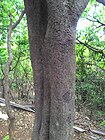Note: This is a project under development. The articles on this wiki are just being initiated and broadly incomplete. You can Help creating new pages.
Difference between revisions of "Meyna laxiflora"
(→External Links) |
|||
| Line 3: | Line 3: | ||
==Uses== | ==Uses== | ||
{{Uses|Inflammation}}, {{Uses|Gastrointestinal disorder}}. | {{Uses|Inflammation}}, {{Uses|Gastrointestinal disorder}}. | ||
| + | |||
| + | ===Food=== | ||
| + | Hibiscus sabdariffa can be used in Food. <ref name="Forest foods of Western Ghat"/> | ||
==Parts Used== | ==Parts Used== | ||
| Line 27: | Line 30: | ||
===Prabhava=== | ===Prabhava=== | ||
| + | |||
| + | ===Nutritional components=== | ||
| + | Hibiscus sabdariffa Contains the Following nutritional components like - <ref name="Forest foods of Western Ghat"/> | ||
==Habit== | ==Habit== | ||
| Line 72: | Line 78: | ||
<ref name="Leaf">[http://www.flowersofindia.net/catalog/slides/Muyna.html Morphology]</ref> | <ref name="Leaf">[http://www.flowersofindia.net/catalog/slides/Muyna.html Morphology]</ref> | ||
<ref name="How to plant/cultivate">[http://wildedibles.teriin.org/index.php?album=Wild-edibles/Fruits/Meyna-laxiflora Cultivation]</ref> | <ref name="How to plant/cultivate">[http://wildedibles.teriin.org/index.php?album=Wild-edibles/Fruits/Meyna-laxiflora Cultivation]</ref> | ||
| − | |||
| − | |||
<ref name="Common names">[http://www.flowersofindia.net/catalog/slides/Muyna.html Common names]</ref> | <ref name="Common names">[http://www.flowersofindia.net/catalog/slides/Muyna.html Common names]</ref> | ||
| + | <ref name="Forest foods of Western Ghat">"Forest food for Northern region of Western Ghats" by Dr. Mandar N. Datar and Dr. Anuradha S. Upadhye, Page No.112, Published by Maharashtra Association for the Cultivation of Science (MACS) Agharkar Research Institute, Gopal Ganesh Agarkar Road, Pune</ref> | ||
</references> | </references> | ||
Revision as of 15:02, 12 November 2021
Meyna laxiflora is a species of flowering plant in the family Rubiaceae. It has a world-wide distribution across tropical and subtropical regions.
Contents
- 1 Uses
- 2 Parts Used
- 3 Chemical Composition
- 4 Common names
- 5 Properties
- 6 Habit
- 7 Identification
- 8 List of Ayurvedic medicine in which the herb is used
- 9 Where to get the saplings
- 10 Mode of Propagation
- 11 How to plant/cultivate
- 12 Commonly seen growing in areas
- 13 Photo Gallery
- 14 References
- 15 External Links
Uses
Inflammation, Gastrointestinal disorder.
Food
Hibiscus sabdariffa can be used in Food. [1]
Parts Used
Chemical Composition
The chemicals reported from the plant belong to different classes such as carbohydrates, starch, proteins, tannins, saponins and alkaloids.[2]
Common names
| Language | Common name |
|---|---|
| Kannada | Mullakare, Gobergally |
| Hindi | Muyna, Pundrika |
| Malayalam | NA |
| Tamil | Manakkarai |
| Telugu | Visikilamu, Chegagadda |
| Marathi | NA |
| Gujarathi | NA |
| Punjabi | NA |
| Kashmiri | NA |
| Sanskrit | Pindituka |
| English | Muyna |
.[3]
Properties
Reference: Dravya - Substance, Rasa - Taste, Guna - Qualities, Veerya - Potency, Vipaka - Post-digesion effect, Karma - Pharmacological activity, Prabhava - Therepeutics.
Dravya
Rasa
Guna
Veerya
Vipaka
Karma
Prabhava
Nutritional components
Hibiscus sabdariffa Contains the Following nutritional components like - [1]
Habit
Identification
Leaf
| Kind | Shape | Feature |
|---|---|---|
| Simple | Ovate-oblong | Leaves are arranged oppositely or whorls of three. Strong spines are bent at an acute angle. |
Flower
| Type | Size | Color and composition | Stamen | More information |
|---|---|---|---|---|
| Greenish-white | Flower cymes occur in leaf axils, fascicled on a short peduncle. Flowers are small. The stigma is 4-5-lobed. | {{{5}}} |
Fruit
| Type | Size | Mass | Appearance | Seeds | More information |
|---|---|---|---|---|---|
| 5-6 long, oblong-reniform | Yellow | Fruit is of the size of a cherry, turbinate, smooth, when ripe, succulent. |
Other features
List of Ayurvedic medicine in which the herb is used
Where to get the saplings
Mode of Propagation
How to plant/cultivate
Direct sowing of seeds.[5]
Commonly seen growing in areas
Photo Gallery
References
- ↑ 1.0 1.1 "Forest food for Northern region of Western Ghats" by Dr. Mandar N. Datar and Dr. Anuradha S. Upadhye, Page No.112, Published by Maharashtra Association for the Cultivation of Science (MACS) Agharkar Research Institute, Gopal Ganesh Agarkar Road, Pune
- ↑ Chemical constituents
- ↑ Common names
- ↑ Morphology
- ↑ Cultivation
External Links
- Ayurvedic Herbs known to be helpful to treat Inflammation
- Ayurvedic Herbs known to be helpful to treat Gastrointestinal disorder
- Herbs with Fruits used in medicine
- Herbs with Leaves used in medicine
- Herbs with common name in Kannada
- Herbs with common name in Hindi
- Herbs with common name in Tamil
- Herbs with common name in Telugu
- Herbs with common name in Sanskrit
- Herbs with common name in English
- Habit - Evergreen tree
- Index of Plants which can be propagated by Seeds
- Herbs that are commonly seen in the region of Humid tropical forests
- Herbs
- Tree
- Ayurvedic herbs that don't have seed photos
- Rubiaceae





